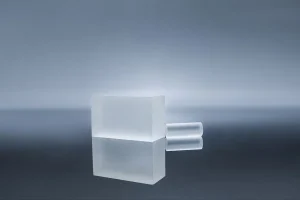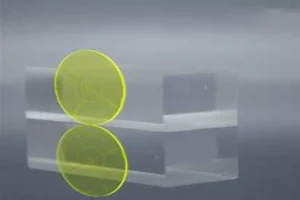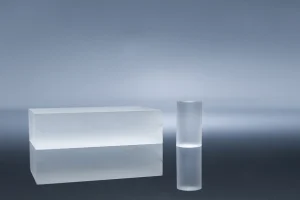Chapter 1: Introduction to Nd YAG Laser Technology
Nd YAG (neodymium-doped yttrium aluminum garnet) lasers have been essential in industry, medicine, research, and other fields for several decades. They emit laser light at a wavelength of 1064 nanometers in the infrared range of the electromagnetic spectrum. Nd YAG lasers are known for their high efficiency, versatility, and reliability, making them an essential part of many industrial processes and medical procedures.
History of Nd YAG Lasers Nd YAG lasers were developed in the 1960s by J.E. Geusic and H.M. Marcos at Bell Labs. The first Nd YAG laser was pumped by a flashlamp and emitted laser light at 1064 nm. Since then, Nd YAG lasers have undergone significant developments and are now used in various industries and applications.

Nd YAG crystal
Properties of Nd YAG Lasers Nd YAG lasers consist of a neodymium-doped yttrium aluminum garnet crystal as the gain medium. The crystal is typically 1 to 5 mm in diameter and 10 to 100 mm in length. The neodymium ions in the crystal are excited by a pump source, such as a flashlamp or laser diode, to produce a population inversion. When a resonant cavity stimulates this population inversion, it emits laser light at 1064 nm.
Nd YAG lasers have several properties that make them attractive for various applications. They have a high output power, a narrow linewidth, and a high beam quality. They are also highly efficient, with up to 20% electrical-to-optical conversion efficiencies.
Applications of Nd YAG Lasers in Manufacturing Nd YAG lasers are widely used in the manufacturing industry for various applications. They are used for cutting, welding, drilling, and surface treatment of metals, ceramics, and other materials. Nd YAG lasers are also used for marking, engraving, and 3D printing plastics, metals, and other materials.
In welding, Nd YAG lasers are used for high-precision welding of small parts and for welding dissimilar materials, such as copper and aluminum. In cutting, Nd YAG lasers are used for high-precision cutting of thin metals and for cutting ceramics and other hard materials.
In addition to manufacturing, Nd YAG lasers are also used in scientific research, including spectroscopy, nuclear fusion, and quantum technologies.
Applications of Nd YAG Lasers in Medicine Nd YAG lasers are also
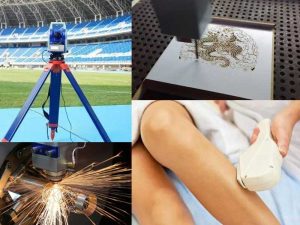
widely used in medicine for various applications. They are used in ophthalmology to treat glaucoma, cataracts, and other eye conditions. Nd YAG lasers are also used in dermatology to remove tattoos, birthmarks, and other skin lesions.
Dentistry uses Nd YAG lasers for soft tissue procedures, such as gingivectomy and periodontal therapy. Nd YAG lasers are also used in urology to treat kidney stones and other urological conditions.
Advancements in Nd YAG Laser Technology Nd YAG laser technology have significantly increased recently. These advancements have led to improved Nd YAG lasers’ performance, efficiency, and versatility.
One area of advancement is in the development of fiber lasers. Fiber lasers are a type of Nd YAG laser that uses an optical fiber as the gain medium. Fiber lasers are highly efficient, with up to 50% electrical-to-optical conversion efficiencies. They are also highly reliable and have a long lifespan.
Another area of advancement is in the development of high-power Nd YAG lasers. These lasers can produce output powers of up to several kilowatts and are used in industrial applications such as cutting.
Chapter 2: Principles of Nd YAG Lasers
Nd YAG lasers are based on stimulated Emission and population inversion principles. These principles allow Nd YAG lasers to produce coherent laser light at a specific wavelength.
Stimulated Emission Stimulated Emission is when a photon interacts 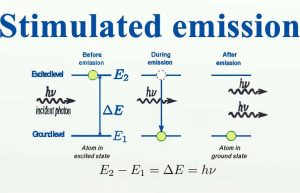 with an excited atom or molecule, causing it to emit another photon that is identical in energy, direction, and phase to the first photon. This process is responsible for the amplification of light in a laser.
with an excited atom or molecule, causing it to emit another photon that is identical in energy, direction, and phase to the first photon. This process is responsible for the amplification of light in a laser.
The gain medium in an Nd YAG laser is a neodymium-doped yttrium aluminum garnet crystal. When the crystal is excited by a pump source, such as a flashlamp or laser diode, the neodymium ions in the crystal become excited and reach a higher energy state. When a photon with the same energy as the energy difference between the two energy states interacts with an excited neodymium ion, it stimulates the Emission of another photon with the same power, direction, and phase.
Population Inversion Population inversion is a state in which more atoms or molecules are in an excited state than in a lower energy state. In a laser, a population inversion is necessary for stimulated Emission to occur and for laser light to be produced.
In the Nd YAG laser, the population inversion is achieved by pumping the neodymium-doped yttrium aluminum garnet crystal with a pump source. When the neodymium ions in the crystal absorb energy from the pump source, they become excited and reach a higher energy state. This creates a population inversion, with more neodymium ions in the excited state than in the lower energy state.
Resonant cavity A resonant cavity is a structure that allows light to be amplified and to travel back and forth through the gain medium. The deep hole in a laser is typically made up of two mirrors, one partially reflective and the other fully reflective.
In the Nd YAG laser, the resonant cavity is formed by two mirrors placed at either end of the neodymium-doped yttrium aluminum garnet crystal. When light is produced by stimulated Emission in the crystal, it travels back and forth through the resonant cavity, reflecting off the mirrors and gaining energy with each pass. This amplifies the light and produces coherent laser light at a specific wavelength.
Q-Switching Q-switching is a technique used to produce short, high-energy pulses of laser light. It is achieved by inserting a Q-switch, such as a Pockels cell or an acoustic-optic modulator, into the resonant cavity. The Q-switch blocks the light from escaping the deep hole until a high energy density is reached, at which point the Q-switch is switched off, allowing the laser light to run in a short, high-energy pulse.
Nd YAG lasers are often used in Q-switching mode for laser marking, micromachining, and laser-induced breakdown spectroscopy applications.
Conclusion The principles of stimulated Emission, population inversion, and resonant cavity are essential for understanding how Nd YAG lasers produce coherent laser light. These principles allow Nd YAG lasers to be used in various applications, from manufacturing and material processing to medical procedures and scientific research. Q-switching is a technique that produces short, high-energy pulses of laser light and is an essential feature of Nd YAG lasers.
Chapter 3: Components of Nd YAG Lasers
Nd YAG lasers comprise several components that work together to produce coherent laser light at a specific wavelength. Understanding the members of a Nd YAG laser is essential for understanding how the laser works and how to optimize its performance.
Gain Medium The gain medium in a Nd YAG laser is a neodymium-doped yttrium aluminum garnet crystal. The crystal is typically cylindrical in shape and can range in size from a few millimeters to several centimeters in diameter and length.
The neodymium ions in the crystal are responsible for the amplification of light in the laser. When the crystal is excited by a pump source, such as a flashlamp or laser diode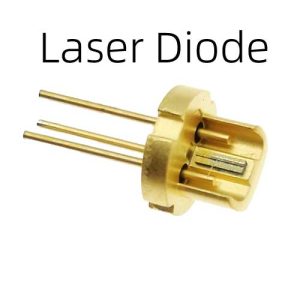 , the neodymium ions become excited and reach a higher energy state. When a photon with the same energy as the energy difference between the two energy states interacts with an excited neodymium ion, it stimulates the Emission of another photon with the same power, direction, and phase. This process is responsible for the amplification of light in the laser.
, the neodymium ions become excited and reach a higher energy state. When a photon with the same energy as the energy difference between the two energy states interacts with an excited neodymium ion, it stimulates the Emission of another photon with the same power, direction, and phase. This process is responsible for the amplification of light in the laser.
Pump Source, The pump source in a Nd YAG laser, is typically a flashlamp or a laser diode. The pump source excites the neodymium ions in the gain medium and creates a population inversion.
Flashlamps are typically used in pulsed Nd YAG lasers and consist of a glass envelope filled with a gas, such as xenon or krypton. When a high voltage is applied to the electrodes at either end of the lamp, a current flows through the gas, causing it to emit light. This light is absorbed by the neodymium-doped yttrium aluminum garnet crystal, exciting the neodymium ions and creating a population inversion.
Laser diodes are typically used in continuous-wave Nd YAG lasers and consist of a semiconductor material that is doped with impurities to create a p-n junction. When a voltage is applied across the p-n junction, electrons and holes recombine, emitting photons at a specific wavelength. The neodymium-doped yttrium aluminum garnet crystal absorbs this light, exciting the neodymium ions and creating a population inversion.
The resonator in a Nd YAG laser is a structure that allows light to be amplified and travel back and forth through the gain medium. The resonator is typically made up of two mirrors, one of which is partially reflective and the other is fully reflective.
The mirrors in the resonator are responsible for reflecting the light back and forth through the gain medium, amplifying the light with each pass. The partially reflective mirror allows some light to escape the resonator and become the laser output.
Q-Switch The Q-switch in a Nd YAG laser is a device used to produce short, high-energy pulses of laser light. The Q-switch is typically inserted into the resonator and blocks the light from escaping the resonator until a high energy density is reached, at which point the Q-switch is switched off, allowing the laser light to escape in a short, high-energy pulse.
Two main types of Q-switches are used in Nd YAG lasers: Pockel cells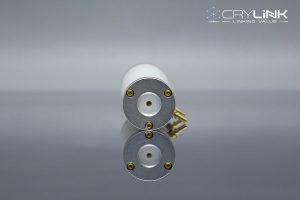 and acousto-optic modulators. Pockels cells are electro-optic devices that use a voltage to change the polarization of the laser light, allowing it to pass through the partially reflective mirror. Acousto-optic modulators use a sound wave to diffract the laser light, allowing it to pass through the partially reflective mirror.
and acousto-optic modulators. Pockels cells are electro-optic devices that use a voltage to change the polarization of the laser light, allowing it to pass through the partially reflective mirror. Acousto-optic modulators use a sound wave to diffract the laser light, allowing it to pass through the partially reflective mirror.
Cooling System, The cooling system in a Nd YAG laser removes the heat generated by the pump source and the gain medium. This is important for maintaining the temperature of the gain


